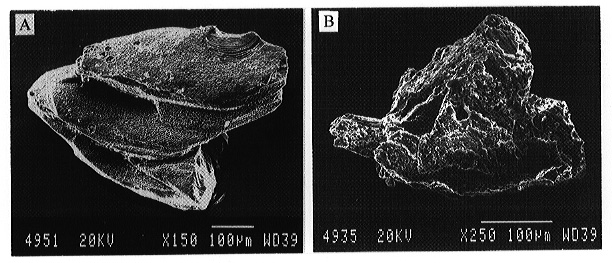

The discovery of diamonds at the Popigai impact structure, Siberia, in 1972 showed that diamonds form not only in the Earth´s mantle but also at the surface as a result of impacts of extraterrestrial bodies (asteroids, comets). Our recent discovery of impact diamonds at Sudbury provides further evidence for the exogenic formation process. The study of impact diamonds and their characteristics has two important aspects. First, due to their strong chemical and physical resistance impact diamonds are regarded as important indicators of especially ancient impact events. For instance, it has been suggested that carbonados represent remnants of precambrian impact craters, which have disappeared due to exogenic activity on Earth. Secondly, impact diamonds exhibit some unusual physical properties such as extreme hardness (Mohs hardness > 10), which might have technological applications.
We have undertaken a combined X-ray, SEM, and TEM study on impact diamonds
from the Popigai and Sudbury craters in order to understand better the
transformation mechanism and resulting physical properties and characteristics.
Diamonds have been extracted from the typical impact melt rocks at Popigai
(suevites and tagamites) and, in the case of Sudbury, from the carbon-bearing
Black Onaping formation, which consists of reworked suevite breccias. X-ray
diffraction reveals the polycrystalline nature of diamonds and the presence
of graphite and up to 20% lonsdaleite, the hexagonal high-pressure carbon
polymorph. Popigai and Sudbury diamonds differ in morphology. Popigai diamonds
show a tabular shape (Fig. 3.4-1a), which is inherited
 |
|
from the precursor mineral graphite. Distinct surface striations on Popigai diamonds indicate additionally the inheritance of primary twinning of graphite. Sudbury diamonds are blocky in morphology and their surfaces are corroded and pitted (Fig. 3.4-1b). Untransformed graphite from the same formation shows similar morphological characteristics. In contrast to the compact Popigai diamonds, Sudbury diamonds are relatively fragile and can be disaggregated by light pressing. TEM observations reveal similar microstructural characteristics of Popigai and Sudbury diamonds. The polycrystalline aggregates are composed of numerous diamond crystallites with mean grain sizes of 100 nm to 1 µm. The crystallites show preferred orientations and are sometimes arranged in bands representing primary twins in precursor graphite. Individual crystallites contain numerous planar defects parallel to {111}, which likely represent stacking faults. Clusters of stacking faults may represent lonsdaleite lamellae. The orientation relationship between diamond and lonsdaleite was found to be (111)DIA // (100)LONS.
Altogether, the investigations indicate that impact diamonds form by solid state transformation of graphite. The characteristics of the precursor graphite exert an important control on the resulting properties of diamonds. The first discovery of impact diamonds at Sudbury is a further unequivocal argument for the impact origin of this geological structure.

Tel: +49-(0) 921 55 3700 / 3766, Fax: +49-(0) 921 55 3769, E-mail: bayerisches.geoinstitut(at)uni-bayreuth.de
 Previous page
Previous page